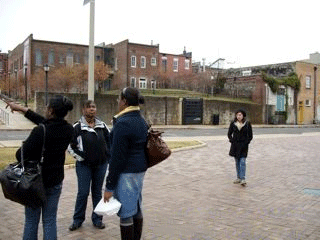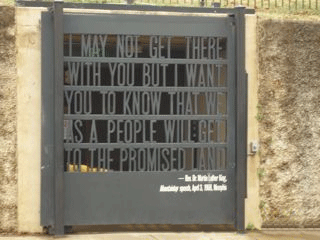While we enjoyed our time off in Memphis, our original motivation for coming here was to study the later Civil Rights Movement, including the turn to social and economic issues and the assassination of Martin Luther King, Jr. on April 4, 1968. The site of the assassination, the Lorraine Motel, was turned into the National Civil Rights Museum in 1991.

The museum purchased the property across the street (the boarding house from which Dr. King was shot) in 2001. It now contains a reconstruction of the rooms the assassin used, along with many artifacts from the shooting and an extensive review of the investigations into and conspiracy theories surrounding the conviction of James Earl Ray. But by far the most compelling sights for us were the completely intact façade and balcony of the motel. A wreath still marks the spot where King stood at the moment he was shot. Room 306 has been recreated to look exactly as it did in the police photos. It was a somber moment as we all stood together, looking up at the balcony, visualizing the events of that day.
Student Responses:
Georgia: Today we went to the National Civil Rights Museum at the Lorraine Motel the site where Dr. Martin Luther King was assassinated. Two things touched me about being at this Civil Right museum: one is that the site looked as if it was frozen in time, never changing from April 4, 1968; the second thing that moved me was that it allowed me to come full circle with life and death of Dr. King. I saw his birth home in Atlanta, I stood at the pulpit where he preached at Dexter Baptist Church in Montgomery Alabama, stood around the table where he formed Southern Christian Leadership Conference (SCLC) and wrote some of his famous speeches, I looked at the spot where his house was bombed , I touched the bars where he was jailed and wrote the famous “Letter from Birmingham City Jail,” I touched the pulpit that he used during his famous “How long, not long “speech at the end of the Selma to Montgomery march and now finally I saw the balcony where he was assassinated and saw the place where the assassin stood and killed the dreamer but not the dream.In these last few days I have seen where Dr. King took his first and last breath. He was a martyr for the cause, a cause that was paid with the price of his life as stated, “If physical death is the price that I must pay to free my white brothers and sisters from a permanent death of the spirit, then nothing can be more redemptive.” He worked and died to correct the triple evils of racism, poverty and war. He knew that his death was imminent but also knew his dream would live on. “I may not get there with you, but I want you to know tonight that we as a people will get to the Promised Land. So I’m happy tonight. I’m not worried about anything. I’m not fearing any man.”Through these commemorations I got to understand the dynamics of this remarkable man. A man whose life, death, struggles and triumphs have allowed me to follow my dreams.
Ewo: As we walked toward the Lorraine motel, I felt like I was entering a graveyard. The gray of the day also definitely contributed to this feeling. And then there it was, room 306, where on unsuspecting day he was murdered. I pictured him stepping out on to the balcony. I could almost hear the shot that rang out. And then in my head was the image of the men pointing towards where the shot came. Honestly, although the museum was informative, entering the portion in which you could see into his room was for me was the pinnacle. Again, my thoughts were racing with images of what he did and said that fateful day. I looked outside the window, across the street to where James Earl Ray supposedly shot Dr. King. Across the street in large, black, iron letters, is an excerpt for his “from the Mountaintop” speech. It reads “I may not get there with you. But we as a people will get to the promised land.” How prophetic!!! There is no doubt in my mind that he knew, or rather, he felt that soon he would die. But his death was not in vain. He died in the midst of a righteous cause whose movement continued after his death. He has helped not only the people of this nation but what he called the “beloved community” of global citizens.
Peter: Today we went to the Lorraine Motel, the sight of the Martin Luther King Jr. assassination on April 4th, 1968. The motel has since been turned into a Civil Rights Museum. In terms of the museum itself, it was definitely one of the, if not the best museum we have been to yet. It seems to cover more aspects of the Civil Rights Movement than any other museum that we have been to yet, and I really appreciated that. What really moved me was being able to see the balcony that Martin Luther King had been shot on. I’ve seen the balcony 1000’s of times in pictures, as it is one of the most infamous images of the movement. Being there was a different story. I felt humbled to be there in the presence of the space that marked the end of the life and beginning of the legacy that is Martin Luther King Jr. It really put things into perspective for me about life and how we shouldn’t take it for granted. Martin Luther King is a man who in name and legacy, will live forever, but he was cut down because of another man’s hatred for humanity. Yet at the same time, Dr. King was assassinated at a young age and accomplished so much before his 40thbirthday. In his lifetime, he accomplished more than generations before him had. He gave not just African-Americans, but Americans a dream to aspire to, a goal to strive toward, a mission to accomplish. This was so powerful to me, and it’s a feeling that I am confident that I will not soon forget.




